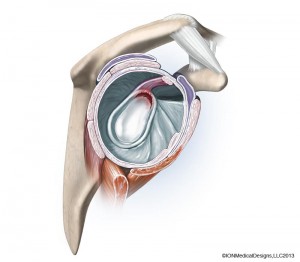The SLAP lesion
A SLAP injury to the shoulder usually is caused by one of two main causes. A fall on an outstretched arm can lever the shoulder upward and tear certain tissues. A second cause is more of a chronic tearing. It is characteristically found in over head throwing athletes such as pitchers or quarterbacks, also with tennis players, racquetball players and volleyball players. The cocking motion slowly can torque the shoulder creating a particular tear pattern. These athletes complain of pain in the throwing motion, weakness of the arm, occasionally clicking, loss of internal rotation, and in some cases a so-called dead arm.
The diagnosis often is missed. We have learned to have a high index of suspicion which has made diagnosis more common. A characteristic physical exam which tests the biceps tendon at certain angles is the first step. Then an MRI with contrast fluid injected into your shoulder is used to help with the diagnosis. The test is designed to identify a possible tear of the superior (S) labrum (L) anterior (A-front) to posterior (P-back) – a SLAP lesion. (see the anatomy of the shoulder)
Treatment for the SLAP lesion usually starts with Physical Therapy and anti-inflammatorys. However, if this fails, then a surgical option should be discussed. The operation, usually done arthroscopically, is designed to repair the superior labrum injury. This is done with small boney anchors (in some cases bio-absorbable) attached to sutures and the labrum is repaired. Initial rehabilitation is about 3 months but most patients will not be allowed to throw hard until 6-9 months.
